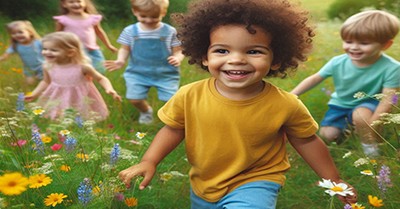Nature programs in early childhood settings are a fantastic way to connect children with the natural world and promote holistic development. The following article provides information on Key Aspects Of Nature Programs, Benefits of Nature Programs, How To Start A Nature Program, Nature Programs and The EYLF, Nature Activity Ideas and more.
Key Aspects of Nature Programs
- Outdoor Exploration: Encouraging children to spend time outdoors, exploring natural environments like gardens, parks, and forests.
- Nature-Based Activities: Integrating activities such as gardening, nature walks, and wildlife observation into the curriculum.
- Natural Materials: Using natural materials like leaves, stones, and water in play and learning activities.
- Environmental Education: Teaching children about the environment, sustainability, and the importance of conservation.
Benefits of Nature Programs
- Cognitive Development: Nature play enhances cognitive skills, including attention, memory, and problem-solving.
- Physical Health: Outdoor activities promote physical health by encouraging movement and exercise.
- Emotional Well-Being: Nature has a calming effect and can reduce stress and anxiety in children.
- Social Skills: Group activities in nature foster cooperation, communication, and social interaction.
- Creativity and Imagination: Natural environments stimulate creativity and imaginative play.
Implementing nature programs in early childhood settings can provide children with enriching experiences that support their overall development and foster a lifelong appreciation for the natural
world.
How To Start A Nature Program
Starting a nature program in an early childhood setting is a wonderful initiative that can have a lasting positive impact on children. Here’s a step-by-step guide to help you get started:
1. Assess Your Environment
- Identify natural spaces available: gardens, parks, or even a designated outdoor area at your center.
- Consider safety measures and access to these natural environments.
2. Plan Your Curriculum
- Incorporate nature-based activities that align with early childhood education standards.
- Include activities like nature walks, gardening, wildlife observation, and using natural materials in play.
3. Engage Stakeholders
- Involve parents, caregivers, and the community in the program.
- Seek input from Aboriginal and Torres Strait Islander (ATSI) community members to integrate cultural perspectives.
4. Develop Policies and Procedures
- Create guidelines for outdoor play and safety.
- Ensure all staff are trained in supervising nature activities and handling emergencies.
5. Gather Resources
- Collect materials needed for nature activities (e.g., seeds, gardening tools, magnifying glasses).
- Consider educational resources that support environmental education and sustainability.
6. Integrate Into Daily Routine
- Schedule regular outdoor time for children to explore and engage with nature.
- Use natural materials in indoor activities to maintain a connection with the outdoors.
7. Evaluate and Adapt
- Monitor the program’s progress and gather feedback from children, parents, and staff.
Make adjustments as needed to enhance the program and address any challenges.
Nature Programs and The EYLF
Nature programs align beautifully with the Early Years Learning Framework (EYLF) and can significantly enhance children's learning and development. Here’s how nature programs connect with the EYLF:
Outcome 1: Children have a strong sense of identity
- Nature programs encourage children to explore their environment, fostering a sense of independence and self-confidence.
- Activities like nature walks and gardening help children develop a connection with the natural world, enhancing their sense of belonging.
Outcome 2: Children are connected with and contribute to their world
- Nature-based activities promote an understanding of the environment and sustainability.
- Children learn about the interdependence between people, plants, animals, and the land, fostering respect and responsibility.
Outcome 3: Children have a strong sense of well-being
- Outdoor play and interaction with nature contribute to physical health and emotional well-being.
- Nature programs provide opportunities for physical activity, reducing stress and promoting overall well-being.
Outcome 4: Children are confident and involved learners
- Nature programs encourage exploration, curiosity, and problem-solving skills.
- Children engage in hands-on learning experiences, developing their confidence and involvement in learning.
Outcome 5: Children are effective communicators
- Nature-based activities provide rich opportunities for language development and communication.
- Children learn to express their ideas, negotiate roles, and collaborate with peers during nature play.
Nature Program Activity Ideas
Here are some engaging and educational nature program activity ideas for early childhood settings:
-
Gardening
-
Planting Seeds: Let children plant seeds in small pots or a garden bed. Teach them about the plant life cycle and how to care for plants.
-
Herb Garden: Create a small herb garden and encourage children to explore different scents and tastes.
-
-
Nature Walks
-
Treasure Hunt: Organize a nature treasure hunt where children can collect items like leaves, rocks, and flowers. Discuss the items they find.
-
Bird Watching: Take children on a walk to observe and identify different birds. Provide binoculars and bird identification cards.
-
-
Art with Nature
-
Leaf Printing: Use leaves to create prints with paint on paper. Children can explore different shapes and textures.
-
Nature Collages: Create collages using natural materials like leaves, flowers, and twigs.
-
-
Outdoor Play
-
Mud Kitchen: Set up an outdoor kitchen where children can play with mud, water, and natural materials to create "meals."
-
Sensory Play: Create sensory bins with sand, water, pebbles, and shells for tactile exploration.
-
-
Environmental Education
-
Recycling Projects: Teach children about recycling by creating art projects from recyclable materials.
-
Composting: Start a compost bin and show children how food scraps turn into nutrient-rich soil.
-
-
Animal Observation
-
Insect Safari: Provide magnifying glasses and guide children on a hunt for insects. Discuss their habitats and behaviors.
-
Pet Care: Introduce a classroom pet and involve children in caring for it, learning about its needs and habitat.
-
-
Storytelling and Books
-
Nature Stories: Read books about nature and the environment. Encourage children to share their own stories and experiences.
-
Outdoor Storytime: Hold storytime sessions outdoors, surrounded by nature.
-
-
Water Play
-
Pond Dipping: If safe and accessible, take children to a pond to explore aquatic life with nets and containers.
-
Water Painting: Provide brushes and containers of water for children to "paint" on sidewalks and rocks.
-
Implementing these activities can create a rich and engaging nature program that supports children's holistic development and fosters a love for the natural world.
Further Reading
ACECQA Publishes New Guidance Information On QA1 Nature Programs
Bush Kinder
Benefits Of Outdoor Area
How Does Nature Affect A Child's Development
Learning With Nature







 As an Educator in Australia, your pay rate falls under the Children’s Services Award 2010. This award states the minimum amount that an employer can
As an Educator in Australia, your pay rate falls under the Children’s Services Award 2010. This award states the minimum amount that an employer can When working as a qualified Early Childhood Teacher (with a university degree) within a service, your rate of pay will come from the Educational Services
When working as a qualified Early Childhood Teacher (with a university degree) within a service, your rate of pay will come from the Educational Services When working as a Diploma Qualified Educator your pay rate is from the Children's Services Award 2010. This Award states your minimum rate of pay
When working as a Diploma Qualified Educator your pay rate is from the Children's Services Award 2010. This Award states your minimum rate of pay When working as a Cert 3 Qualified Educator, your pay rate is from the Children's Services Award 2010. This Award states your minimum rate of
When working as a Cert 3 Qualified Educator, your pay rate is from the Children's Services Award 2010. This Award states your minimum rate of Educational Leaders play a crucial role in their early childhood service by ensuring that the educational program aligns with best practices and supports the holistic
Educational Leaders play a crucial role in their early childhood service by ensuring that the educational program aligns with best practices and supports the holistic In early childhood education and care, ratios are more than a technicality—they are a frontline safeguard. Every child deserves responsive supervision, emotional connection, and developmental
In early childhood education and care, ratios are more than a technicality—they are a frontline safeguard. Every child deserves responsive supervision, emotional connection, and developmental With the new national child safety reforms kicking in on 1 September 2025, early childhood services like yours have a real opportunity to lead the
With the new national child safety reforms kicking in on 1 September 2025, early childhood services like yours have a real opportunity to lead the Here’s a comprehensive Mobile Phone and Smart Watch Policy tailored for early childhood education and care (ECEC) services in Australia, aligned with the latest 2025
Here’s a comprehensive Mobile Phone and Smart Watch Policy tailored for early childhood education and care (ECEC) services in Australia, aligned with the latest 2025 The Sea of Fish Challenge is a national initiative that invites children, educators, families, and communities to create and display fish artworks as a symbol
The Sea of Fish Challenge is a national initiative that invites children, educators, families, and communities to create and display fish artworks as a symbol Across the early childhood education and care sector, educators are sounding the alarm: current staffing ratios are insufficient to deliver safe, meaningful, and developmentally appropriate
Across the early childhood education and care sector, educators are sounding the alarm: current staffing ratios are insufficient to deliver safe, meaningful, and developmentally appropriate


